Today is Day 18 of a 31 day series on creating and cultivating an eclectic home. For some crazy reason, I have accepted The Nester’s challenge to write on the same theme every day for the month of October. This may end up killing me. Or you. But, I appreciate you reading and welcome your comments.
I have a confession. I used to spend hours watching “The Christopher Lowell Show” on the Discovery Channel. Back just 10 years ago, there were very few design shows on TV. It was thrilling to watch someone design a room, a task usually performed behind closed doors at the hand of a pricey interior designer.
I’m going to be honest – I thought Christopher’s style and designs were mediocre, even at the time. Occasionally he’d produce some interesting ideas, but most of the show was cheesy schtick wrapped up in costumes and faux wall treatments. If you ever watched the show, you know just what I’m talking about.
But hidden in all of the craziness, Christopher taught his viewers a skill that I continue to use all these years later. He honed a formula for layering a room, and passed it along to us. I know it’s killing many of you that I post photos of my master bedroom in progress with no accessories and no window coverings. Well, it’s because Christopher taught me to think about my room thoughtfully as layers instead of just throwing it all together.
Although the photos are terribly dated, I still feel that his “Seven Layers of Design” are worth being shared. I know it’s difficult, but you should look past the example photos and see the method being described. If you consider decorating in layers while you are putting together an eclectic room, your room will end up with far more visual interest.
The Seven Layers of Design
Layer 1: Paint and Architecture – Consider the paint color of the walls and the ceiling. I know that seems backwards, as most people choose a paint color based upon upholstery fabrics. In my opinion, when you are working within a room, you generally know what color direction you are headed. If you choose a neutral color (and not beige!) that will work with your color scheme, you will be fine. Also take into account the architecture of the room, such as trims and moldings.
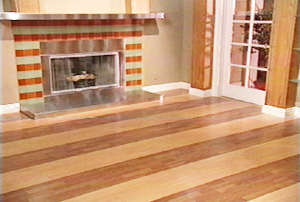
Layer 2: Installed Flooring – Most DIYers who are redoing a room are likely working with existing wall-to-wall flooring, be it hardwood, tile, laminate or carpet. If you get to replace your flooring, keep it simple and without bold patterns (and not at all like the floor shown below, which totally scares me when paired with that fireplace).
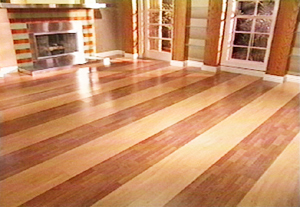
Layer 3: High Ticket Upholstery Items – Now you add in your larger and likely more expensive pieces of furniture. Lean toward solid colors, as these items are still considered part of the background. Christopher suggests making sure the pieces are of solid construction, so they can withstand repeated reupholstering in the future. He also suggests that they be of simple, more classic lines, but again, that doesn’t necessarily mean they have to be beige.
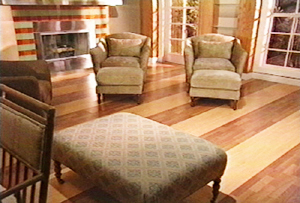
Layer 4: Accent Fabrics – Now’s the time to add in pattern and texture. Do it through pillows, window treatments and area rugs. This is where I like to go wild and do something a little funky (unless I paint a crazy pattern on my walls and go much tamer with my accent fabrics).
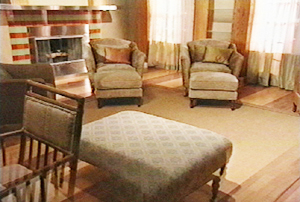
Layer 5: Non-upholestered Furnishings – Christopher describes these pieces, such as side tables and coffee tables, as the work horses of the room. They are the pieces that serve your storage and display functions. I also feel like these are the pieces that can help inject some major color into your room if you look beyond traditional wood stains and metal finishes.
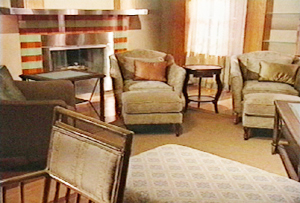
Layer 6: Accessories – Now is finally the time to add accessories. Hang your art, group smaller objects into collections, and vary objects by height and color.
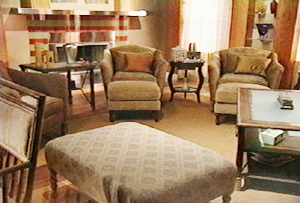
Layer 7: Lighting and Plants – Lighting is extremely important. Christopher says that light from the midpoint of the room, such as from lamps, is the most important. You can use spotlights to cast light directly onto particular objects. He was also big into uplights which, when placed behind furniture or plants, cast interesting light and shadows on walls (I’m not sure that uplights are particularly of the moment, though). A few well-placed plants provide life and energy in a room.
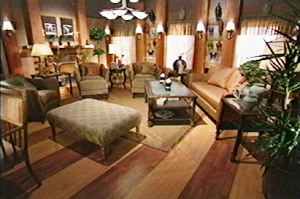
Well, there you have it. As dated as it seems, I generally follow this formula when putting together a room. For my master bedroom, I am finally on Level 6. I’m hoping to be finished by the end of this month and will be able to bring you the big reveal. For those who have been reading along for a while, I think you will be very surprised with how far it’s come since the last time I shared my progress.
What do you think about the Seven Layers of Design? Do you feel like it would help you to think about putting together your room in a more thoughtful manner?
Love that pottery! Would love to win a free piece.
I’m so glad to see someone else who loves Christopher! I still refer to that very book – and always hear him in my head when I’m telling clients the importance of layering! Thanks for posting this – brought a smile to my day! 😉
Hmmm. I think this is a very interesting description of the “deconstruction” of the elements of a room. BUT, I have never ever in my life designed a room in a linear fashion like this — nor do I think I would want to. Maybe if you are really rich and hire a designer, the designer would do it this way, all in order. (And to me, when it’s done this way, it would look too “decorator”.) If you are a normal, everyday home-decorating woman or man, on the other hand, I think the room all comes together in a much more random-order fashion. You find things when you find things. Much more interesting — and much more eclectic. All that said, Lindsay, yes, this is a thought-provoking and useful deconstruction…. Thanks!
This is so helpful for someone who isn’t design focused, but wants a lovely home. These steps are so simple I feel like I could easily apply them to a room. Thanks Lindsay!
I loved watching that show! I used to record them on my VCR (remember those?) and spent hours watching the shows on the weekends. He used those up lights and plants and would take us on tours of beautiful homes (well, they seemed beautiful at the time!).
I believe his background was in theater where he did set designing. I wonder what he’s doing now?
Judy
Christopher Lowell and Lynette Jennings – the background noise to my first days as a stay at home mom (almost 15 years ago??? That can’t be right!). I remember the day HGTV came out – I thought I’d died and gone to heaven.
Even though the stuff may be “dated,” I think that the concept is classic: great rooms always have layers.
OMG, Lynette Jennings. I had totally forgotten about her! And who was the man and woman who had a show together – I feel like his name was Matt? I couldn’t even watch their stuff at the time!
LOL, I think you are talking about Room By Room with Matt & Sherry. He would build stuff and she would find puffy curtains made from awful fabric to coordinate with the wall paper borders. I watched that show religiously, even though I always wound up thinking the room was ugly at the end.
That’s a blast from the past! ahhh yes, Christopher Lowel, I had the same take on him as you described. But you are so right, the 7 layers of design is a great basic formula. You don’t have to start from scratch with an empty room to use it. If you are looking for a new rug, curtains, lighting, etc. you can step back and look at the “layers” you already have and it helps give you direction.
I love it. I have to admit that I watched the CL show for the giggle factor as much as anything, but you are absolutely right there was a lot of information that could be gleaned from his show . Design and creating a home is completely subjective, so take his suggestions and and add your own style and you’ll create a happy home. Thanks for the memories, and the reminders.
Rick Shaver, PleasantLivingHome
Thank you Lindsay! You are my mentor! I’m loving the 31 days thing and learning a lot! Keep up the good work.
djb
This is almost exactly how I decorate, but I didn’t even know there was a true process! This is fantastic advice! Thanks for the tips! I will be putting them to good use soon…well, hopefully soon!
I’m a Christopher Lowell fan, too! I have the book and still look at it. I have Lynette Jennings’ book, too. I enjoyed her show. Matt and Sandy…not so much 🙂 I love the Seven Layers concept even if I don’t do thinks in that order. If the room doesn’t look right, I can figure out what’s wrong by figuring out what layer is missing!
Christopher Lowell?! He was so much fun to watch, even if the rooms were mediocre. It was the 90’s, he deserves a partial pardon for what was trending then.
Thanks for this!! I need to decorate my front living room, but had no idea how to go about it. I will definitely use the layer approach.
I LOVED Christopher Lowell and though I felt that a lot of his designs were a bit much for our simpler lifestyles, I felt he really pushed us to think outside the box. It always amazed me how his finished product was so spectacular. Could you imagine the striped fireplace and striped floor ever fitting into any room and yet there it was,
AND it looked good in that room. Same concept, different era.
I just found your site, hence the very belated post. Regarding layering, I believe lighting should come before plants, artwork and accessories. This reminds me of a previous day’s post where the lamp was an integrated part of the wall “scape”.